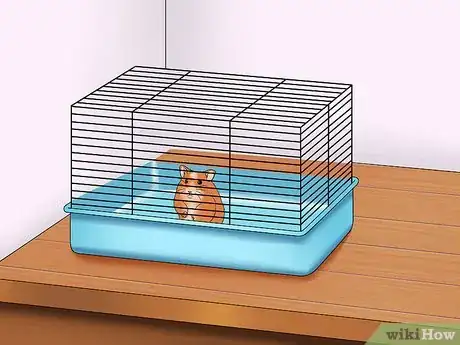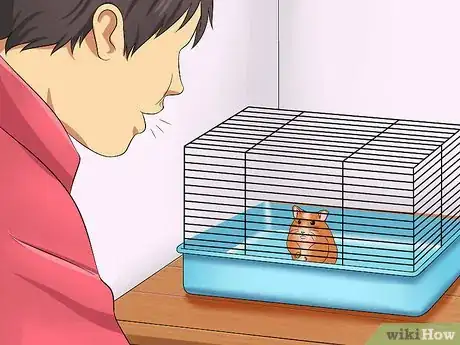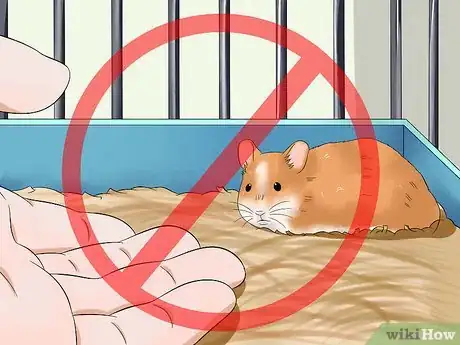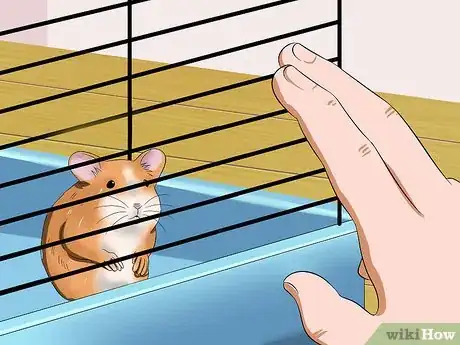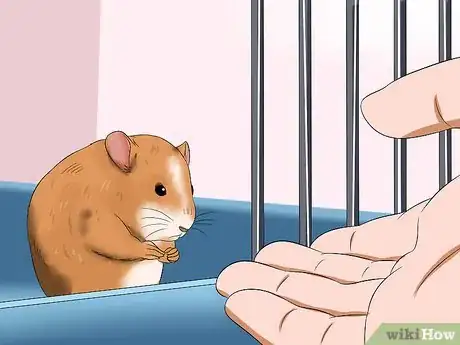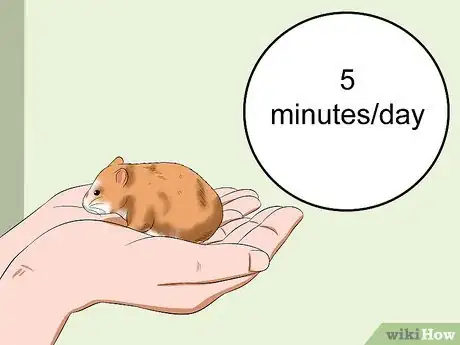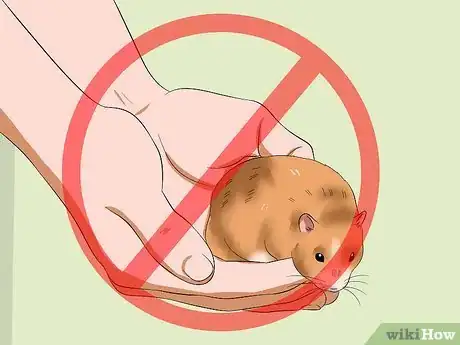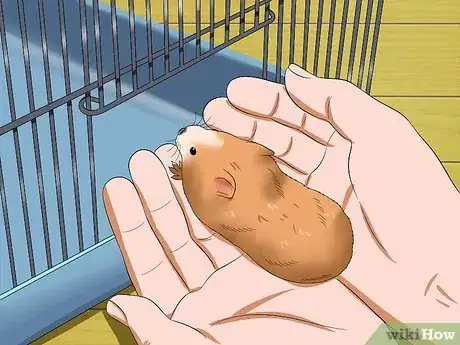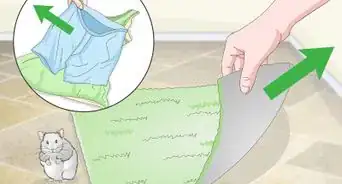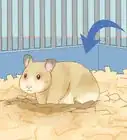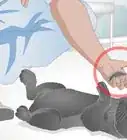This article was co-authored by Pippa Elliott, MRCVS. Dr. Elliott, BVMS, MRCVS is a veterinarian with over 30 years of experience in veterinary surgery and companion animal practice. She graduated from the University of Glasgow in 1987 with a degree in veterinary medicine and surgery. She has worked at the same animal clinic in her hometown for over 20 years.
There are 8 references cited in this article, which can be found at the bottom of the page.
wikiHow marks an article as reader-approved once it receives enough positive feedback. This article received 28 testimonials and 87% of readers who voted found it helpful, earning it our reader-approved status.
This article has been viewed 546,011 times.
Hamsters are cute little animals to keep as pets. They are naturally inquisitive and can be fun to observe in their cages. However, hamsters are not automatically trusting of people.[1] In fact, because of your size (you are hundreds of times larger than your hamster), he may even see you as a predator until proven otherwise.[2] With time, patience, and gentle handling, your hamster will learn to trust you and get to know you for who you are.
Steps
Acclimating Your Hamster to Your Home
-
1Place your hamster’s cage in a good location. Allowing your hamster to acclimate to his/her new environment is an important building block to gaining his trust. Finding a good location for your hamster’s cage will ease his acclimation. A warm room is ideal for your hamster,[3] especially if it is draft free.[4]
-
2Give your hamster time to adjust to your home. Give your hamster at least a few days to acclimate to his new surroundings. During this time, your hamster will start familiarizing himself with where things are in his cage (food, water, sleeping area).
- Do not be concerned if your hamster is washing his face or grooming himself excessively. These are not signs of nervous tension, as is commonly believed. Rather, he is scent marking and claiming his new territory.[7]
- Scent marking allows your hamster to recognize places and items in his new home.[8]
Advertisement -
3Approach your hamster’s cage with care. Your hamster will probably see you as a huge predator at first. You do not want to confirm his perception of you by approaching his cage in a threatening manner. Instead, your approach should be slow and quiet, with no sudden movements or noises.[9]
- Try talking to him in a low and soft voice when you get near to, and reach, his cage.[10]
-
4Stand near his cage. During those first few days of acclimation, your hamster may hide in his cage when you approach it.[11] He may still be very wary of you and his new surroundings. Over time, though, your hamster should relax enough to do normal hamster activities, such as exploring his cage, when you are nearby.[12]
- Talking to him in a low and soft voice may help him relax and be comfortable with your presence.
- You do not need to stand by his cage for long periods of time. Try standing there for a few minutes at a time to see how he reacts to you.
- Once you see him going about his normal business when you are nearby, continue talking to him. The sound of your voice will continue to help him adjust.
- Consider offering him treats when you are near his cage.[13] Place them in the bottom of his cage, since he will probably not be ready to take them from your hand.
-
5Do not handle him. It is very important that you do not touch your hamster during his adjustment period. Acclimating to his new home will be hard enough without you trying to handle him and pick him up. Talking to him and being near his cage will be sufficient.
Handling Your Hamster
-
1Work with your hamster when he is alert. Once your hamster is adjusted to his new home and your presence, you can gain his trust by handling him properly. He will be more receptive to working with you when he is fully awake and alert, which is in the evening.[14]
- Do not wake your hamster up to work with him. If he is sleeping deeply, being woken up suddenly can cause him to jump into defensive mode,[15] which could lead to you being bitten or nipped at.
- If he is busy doing something else when you approach his cage, get his attention by lightly tapping on the cage, moving his water bottle, or softly talking to him.[16]
-
2Wash your hands. Clean hands are important to handling your hamster. If your hands smell like food, your hamster will see your hands as food and will probably try to bite them. Be sure to wash your hands with unscented soap—even a fruit-scented soap could cause your hamster to bite your hands.
- If you have multiple hamsters, wash your hands between handling each one. The smell of one hamster on your hands would lead the next hamster to believe he is being attacked.
-
3Acclimate your hamster to your hand. Your hamster will trust you when he can trust that your hands will not harm him. With your hands freshly washed, slowly place one of your hands in the bottom of his cage. Allow him to explore your hand by smelling it.[17]
- Do not be surprised if your hamster runs and hides when you first place your hand in his cage. From his perspective as a prey animal, your hand reaching into his cage could resemble a large bird swooping down to scoop him up.
- Rest your hand in a non-threatening way, with your fingers curled. Spreading your fingers out could make your hamster think he’s being attacked.
- Do not pull your hand away if he starts to nibble on it. His nibbles are a way of exploring your hand. If you suddenly pull your hand back, you could frighten him and make him more wary of your hand.
- Try offering him treats, talking to him, or stroking his back as he becomes more comfortable with your hand.[18] [19] Eventually, he will take your treats from your hand.[20]
-
4Pick up your hamster. When your hamster is comfortable with your hand, slowly reach into his cage with both hands. Hold your hands like a scoop and wait for your hamster to walk into your hands. Support him with both hands as you slowly lift your hands out his cage.[21] Have him face you when you lift him up—he will know what’s happening to him and will be less likely to jump.[22]
- Your hamster may become skittish and jump off your hands when your hands are still in the cage—let him do so.[23]
- If he seems agitated, calm him down by giving him a treat and/or stroking his back.[24] Talking to him in a soothing voice could also calm him down.
- Your hamster may squeal when you pick him up, signaling that he’s annoyed with being held.[25]
- If he continues to squeal, gently place him back in his cage and try to pick him up at a later time.
- If you are having trouble picking him up with your hands, place an empty mug in his cage and let him climb into it. When he has crawled into the mug, gently ‘pour’ him out of the mug into your hands.
-
5Hold your hamster for short periods of time. Being held by you can be stressful for your hamster. Try holding him for a minute or two initially, then slowly increase the amount of time each time you pick him up. Aim for handling him for about five minutes a day.
-
6Do not let your hamster fall. When you pick up and hold your hamster, do not let him fall. Hamsters have poor eyesight and no depth perception,[28] so your hamster will have no sense of how or low he is from the ground. In addition, your hamster could injure himself if he gets spooked and tries to jump out of your hands when you have him out of his cage.
-
7Return your hamster to his cage. After a few minutes, or when he begins to get agitated, place your hamster back in his cage. Just as you picked him up, use slow and gentle movements to set him back in his cage.[29]
- Try to set your hands on the bottom of his cage before letting him out of your hands.
- Give him a treat when you place him back in his cage.
Expert Q&A
Did you know you can get expert answers for this article?
Unlock expert answers by supporting wikiHow
-
QuestionWhy does a hamster shake?
 Pippa Elliott, MRCVSDr. Elliott, BVMS, MRCVS is a veterinarian with over 30 years of experience in veterinary surgery and companion animal practice. She graduated from the University of Glasgow in 1987 with a degree in veterinary medicine and surgery. She has worked at the same animal clinic in her hometown for over 20 years.
Pippa Elliott, MRCVSDr. Elliott, BVMS, MRCVS is a veterinarian with over 30 years of experience in veterinary surgery and companion animal practice. She graduated from the University of Glasgow in 1987 with a degree in veterinary medicine and surgery. She has worked at the same animal clinic in her hometown for over 20 years.
Veterinarian
-
QuestionDo hamsters like it when you pet them?
 Pippa Elliott, MRCVSDr. Elliott, BVMS, MRCVS is a veterinarian with over 30 years of experience in veterinary surgery and companion animal practice. She graduated from the University of Glasgow in 1987 with a degree in veterinary medicine and surgery. She has worked at the same animal clinic in her hometown for over 20 years.
Pippa Elliott, MRCVSDr. Elliott, BVMS, MRCVS is a veterinarian with over 30 years of experience in veterinary surgery and companion animal practice. She graduated from the University of Glasgow in 1987 with a degree in veterinary medicine and surgery. She has worked at the same animal clinic in her hometown for over 20 years.
Veterinarian
-
QuestionHow do you pick up a hamster without it biting you?
 Pippa Elliott, MRCVSDr. Elliott, BVMS, MRCVS is a veterinarian with over 30 years of experience in veterinary surgery and companion animal practice. She graduated from the University of Glasgow in 1987 with a degree in veterinary medicine and surgery. She has worked at the same animal clinic in her hometown for over 20 years.
Pippa Elliott, MRCVSDr. Elliott, BVMS, MRCVS is a veterinarian with over 30 years of experience in veterinary surgery and companion animal practice. She graduated from the University of Glasgow in 1987 with a degree in veterinary medicine and surgery. She has worked at the same animal clinic in her hometown for over 20 years.
Veterinarian Ideally, take your time to get the hamster used to your hand. Only once the hamster is comfortable being stroked, should you try to pick them up. If it's essential to pick the hamster up before then, say to visit the vet, then drop a clean facecloth over the hamster and scoop them up in this. The cloth will protect your fingers from nips.
Ideally, take your time to get the hamster used to your hand. Only once the hamster is comfortable being stroked, should you try to pick them up. If it's essential to pick the hamster up before then, say to visit the vet, then drop a clean facecloth over the hamster and scoop them up in this. The cloth will protect your fingers from nips.
Warnings
- Your hamster may bite your hand as he's learning to trust you. To discourage biting behavior, gently blow in your hamster’s face when he bites you.⧼thumbs_response⧽
References
- ↑ http://animals.mom.me/hamsters-like-affection-1043.html
- ↑ http://animals.mom.me/hamster-trust-1204.html
- ↑ http://animals.mom.me/hamster-trust-1204.html
- ↑ http://www.chahamsters.org/hamsterhealth.html
- ↑ http://animals.mom.me/hamster-trust-1204.html
- ↑ http://animals.mom.me/hamster-trust-1204.html
- ↑ http://www.hammysworld.com/index.php?p=handling
- ↑ http://www.hammysworld.com/index.php?p=handling
- ↑ http://www.hammysworld.com/index.php?p=handling
- ↑ http://www.hammysworld.com/index.php?p=handling
- ↑ http://animals.mom.me/hamster-trust-1204.html
- ↑ http://animals.mom.me/hamster-trust-1204.html
- ↑ http://animals.mom.me/hamsters-like-affection-1043.html
- ↑ http://www.hammysworld.com/index.php?p=handling
- ↑ http://hamsterific.com/hamster-care/handling-hamster/
- ↑ http://hamsterific.com/hamster-care/handling-hamster/
- ↑ http://animals.mom.me/hamsters-like-affection-1043.html
- ↑ http://hamsterific.com/hamster-care/handling-hamster/
- ↑ http://animals.mom.me/hamster-trust-1204.html
- ↑ http://animals.mom.me/hamster-trust-1204.html
- ↑ http://hamsterific.com/hamster-care/handling-hamster/
- ↑ http://www.chahamsters.org/taminghamsters.html
- ↑ http://www.hammysworld.com/index.php?p=handling
- ↑ http://hamsterific.com/hamster-care/handling-hamster/
- ↑ http://animals.mom.me/happens-hamster-squeaks-1423.html
- ↑ http://hamsterific.com/hamster-care/handling-hamster/
- ↑ http://animals.mom.me/hamster-trust-1204.html
- ↑ http://hamsterific.com/hamster-care/handling-hamster/
- ↑ http://www.hammysworld.com/index.php?p=handling
- ↑ http://animals.mom.me/hamsters-like-affection-1043.html
About This Article
To make your new hamster trust you, put it in a warm, quiet room and let it spend a few days getting used to its new environment. Then, slowly walk up to the cage and stay there for a while, repeating that as often as necessary until the hamster explores its cage as usual while you're watching. At that point, you can start handling the hamster by laying your hands down in its cage until the hamster walks onto them. Scroll down for tips from our Veterinary reviewer on how to prevent your hamster from biting you.
